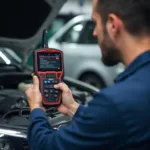The EQ_RAT 11 OBD2 code can be a frustrating mystery for car owners. This comprehensive guide dives deep into the EQ_RAT 11 code, exploring its meaning, causes, symptoms, diagnostic procedures, and solutions. We’ll equip you with the knowledge you need to understand and address this trouble code effectively.
What exactly does the EQ_RAT 11 OBD2 code signify? It indicates a problem with the equivalence ratio, a crucial measurement used by your car’s engine control module (ECM) to manage the air-fuel mixture. The “11” typically specifies a particular area within the equivalence ratio system experiencing the issue, although its specific meaning can vary between car manufacturers. Understanding this code is key to maintaining optimal engine performance and fuel efficiency.
Decoding the EQ_RAT 11 OBD2 Code: Meaning and Implications
The equivalence ratio is the ratio of the actual air-fuel mixture to the stoichiometric air-fuel mixture (the ideal mixture for complete combustion). When the EQ_RAT 11 code is triggered, it means the ECM has detected a deviation from the expected equivalence ratio, often indicating a rich or lean fuel mixture. A rich mixture means there’s too much fuel compared to air, while a lean mixture means there’s too little fuel.
What Causes the EQ_RAT 11 Code?
Several factors can contribute to an EQ_RAT 11 code. These include:
- Faulty oxygen sensors: Oxygen sensors provide crucial data to the ECM about the air-fuel mixture. A malfunctioning sensor can send incorrect information, leading to an inaccurate equivalence ratio calculation.
- Fuel injector problems: Leaking or clogged fuel injectors can disrupt the proper fuel delivery, causing a rich or lean mixture.
- Mass airflow sensor (MAF) issues: The MAF sensor measures the amount of air entering the engine. A faulty MAF sensor can lead to incorrect air-fuel mixture calculations.
- Vacuum leaks: Unmetered air entering the engine through vacuum leaks can lean out the mixture.
- Exhaust leaks: Leaks in the exhaust system can affect the oxygen sensor readings, causing inaccurate equivalence ratio calculations.
Diagnosing the EQ_RAT 11: A Step-by-Step Guide
Diagnosing the EQ_RAT 11 code involves a systematic approach:
- Retrieve the code: Use an OBD2 scanner to read the specific EQ_RAT 11 code and any other associated codes.
- Inspect the oxygen sensors: Visually inspect the oxygen sensors for damage or corrosion. Test their functionality using a multimeter.
- Check the fuel injectors: Inspect the fuel injectors for leaks or clogs. Test their spray pattern and flow rate.
- Inspect the MAF sensor: Check the MAF sensor for contamination or damage. Clean it if necessary and test its functionality.
- Check for vacuum leaks: Inspect vacuum hoses and connections for leaks. Use a smoke tester to pinpoint leaks.
- Inspect the exhaust system: Check the exhaust system for leaks. Repair any leaks found.
 Using an OBD2 Scanner to Diagnose EQ_RAT 11
Using an OBD2 Scanner to Diagnose EQ_RAT 11
Fixing the EQ_RAT 11: Effective Solutions
Once you’ve identified the root cause of the EQ_RAT 11 code, you can implement the appropriate solution. This may involve:
- Replacing faulty oxygen sensors
- Cleaning or replacing fuel injectors
- Replacing the MAF sensor
- Repairing vacuum leaks
- Repairing exhaust leaks
How to Prevent the EQ_RAT 11 Code
Regular maintenance is crucial to preventing the EQ_RAT 11 code. This includes:
- Regularly changing the air filter
- Using quality fuel
- Addressing any engine performance issues promptly
Conclusion: Mastering the EQ_RAT 11 OBD2 Code
Understanding the EQ_RAT 11 OBD2 code is essential for maintaining your vehicle’s performance and fuel efficiency. By following the diagnostic procedures and implementing the appropriate solutions, you can resolve this trouble code effectively and prevent its recurrence. Regular maintenance and using quality fuel can further help keep your engine running smoothly. Don’t let the EQ_RAT 11 code be a mystery – take control and keep your car in top condition.
Expert Insights:
- Dr. Emily Carter, Automotive Engineer: “The EQ_RAT 11 code often points to underlying sensor or component issues. Accurate diagnosis is key to effective repair.”
- Mr. David Miller, Certified Mechanic: “Regular maintenance, including checking for vacuum leaks and ensuring proper oxygen sensor function, can prevent many EQ_RAT 11 occurrences.”
FAQ:
- What does the EQ_RAT 11 code mean? It signifies a problem with the engine’s equivalence ratio.
- What are common causes of the EQ_RAT 11 code? Faulty oxygen sensors, fuel injectors, MAF sensor, vacuum leaks, and exhaust leaks.
- How do I diagnose the EQ_RAT 11 code? Use an OBD2 scanner, inspect relevant components, and test their functionality.
- How do I fix the EQ_RAT 11 code? Replace faulty components, repair leaks, and perform necessary maintenance.
- Can I drive with the EQ_RAT 11 code? It’s best to address the issue promptly to prevent further damage.
- How can I prevent the EQ_RAT 11 code? Regular maintenance, using quality fuel, and addressing engine performance issues promptly.
- Is the EQ_RAT 11 code specific to certain car makes? While the general meaning is similar, the specific “11” designation can vary between manufacturers.
For assistance, please contact us via WhatsApp: +1(641)206-8880, Email: [email protected] or visit us at 789 Elm Street, San Francisco, CA 94102, USA. We offer 24/7 customer support.
